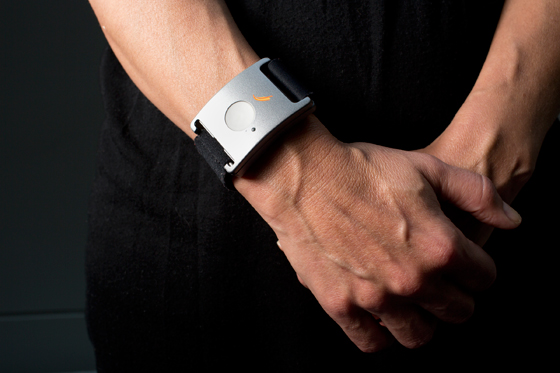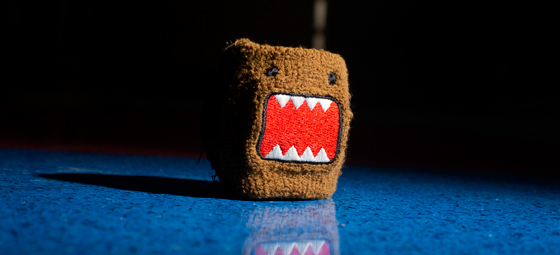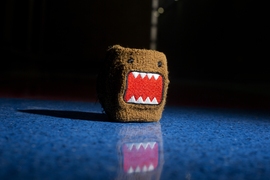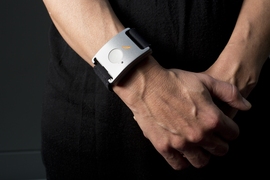
This low-profile wrist sensor, designed by MIT professor Rosalind Picard and her group, has shown early evidence that it can gauge the severity of epileptic seizures as accurately as scalp-worn electroencephalograms, or EEGs (shown at right).
Image: M. Scott Brauer
Rosalind Picard, a professor of media arts and sciences at MIT, and her group originally designed the sensors to gauge the emotional states of children with autism, whose outward behavior can be at odds with what they’re feeling. The sensor measures the electrical conductance of the skin, an indicator of the state of the sympathetic nervous system, which controls the human fight-or-flight response.
In a study conducted at Children’s Hospital Boston, the research team — Picard, her student Ming-Zher Poh, neurologist Tobias Loddenkemper and four colleagues from MIT, Children’s Hospital and Brigham and Women’s Hospital — discovered that the higher a patient’s skin conductance during a seizure, the longer it took for the patient’s brain to resume the neural oscillations known as brain waves, which EEG measures.
At least one clinical study has shown a correlation between the duration of brain-wave suppression after seizures and the incidence of sudden unexplained death in epilepsy (SUDEP), a condition that claims thousands of lives each year in the United States alone. With SUDEP, death can occur hours after a seizure.
Currently, patients might use a range of criteria to determine whether a seizure is severe enough to warrant immediate medical attention. One of them is duration. But during the study at Children’s Hospital, Picard says, “what we found was that this severity measure had nothing to do with the length of the seizure.” Ultimately, data from wrist sensors could provide crucial information to patients deciding whether to roll over and go back to sleep or get to the emergency room.
Surprising signals
The realization that the wrist sensors might be of use in treating epilepsy was something of a fluke. “We’d been working with kids on the autism spectrum, and I didn’t realize, but a lot of them have seizures,” Picard says. In reviewing data from their autism studies, Picard and her group found that seizures were sometimes preceded by huge spikes in skin conductance. It seemed that their sensors might actually be able to predict the onset of seizures.
At the time, several MIT students were working in Picard’s lab through MIT’s Undergraduate Research Opportunities Program (UROP); one of them happened to be the daughter of Joseph Madsen, director of the Epilepsy Surgery Program at Children’s Hospital. “I decided it was time to meet my UROP’s dad,” Picard says.
In a project that would serve as the basis of Poh’s doctoral dissertation, Madsen agreed to let the MIT researchers test the sensors on patients with severe epilepsy, who were in the hospital for as much as a week of constant EEG monitoring. Poh and Picard considered several off-the-shelf sensors for the project, but “at the time, there was nothing we could buy that did what we needed,” Picard says. “Finally, we just built our own.”
“It’s a big challenge to make a device robust enough to withstand long hours of recording,” Poh says. “We were recording days or weeks in a row.” In early versions of the sensors, some fairly common gestures could produce false signals. Eliminating the sensors’ susceptibility to such sources of noise was largely a process of trial and error, Picard says.
Blending in
Additionally, Poh says, “I put a lot of thought into how to make it really comfortable and as nonintrusive as possible. So I packaged it all into typical sweatbands.” Since the patients in the study were children, “I allowed them to choose their favorite character on their wristband — for example, Superman, or Dora the Explorer, whatever they like,” Poh says. “To them, they were wearing a wristband. But there was a lot of complicated sensing going on inside the wristband.” Indeed, Picard says, the researchers actually lost five of their homemade sensors because hospital cleaning staff saw what they thought were ratty sweatbands lying around recently vacated rooms and simply threw them out.

For the study at Children's Hospital, the sensors were housed in wristbands depicting characters selected by the patients.
Image: M. Scott Brauer
Schuele cautions that the new research “makes the assumption that we do have a neurophysiologic marker for SUDEP, which is EEG suppression,” and that assumption is “a little bit controversial.” “But overall,” he adds, “we do think that it’s probably the best marker we have so far.”
Picard is continuing to investigate the possibility that initially intrigued her — that the devices could predict seizures. In the meantime, however, her collaborators at Children’s Hospital are conducting a study that will follow up on the one reported in Neurology, and a similar study is beginning at Brigham and Women’s Hospital. Rather than sweatbands with TV and comic-book characters, however, the new studies will use sensors produced by Affectiva, a company that Picard started in order to commercialize her lab’s work.
Follow @mitnews









